Everything You Need to Know About Guns and Ammo
If you're brand new to guns (or need a refresher) and desire a non-political and rational "for dummies" introduction, this guide is for you.
Maybe yous thought you'd never fifty-fifty own a gun until recently. Or you fired your cousin'due south shotgun that ane time out at the farm 20 years ago and want a refresher earlier taking on the serious responsibility of gun ownership.
Millions of people of all walks of life accept been ownership firearms in record numbers as more rational people reject the culture state of war around this topic and recognize the need for self defence is all the same very real, even in an 'advanced' society. Women, liberals, urbanites, and people of color are some of the fastest growing groups of firearm owners, for example.
Regardless of politics or background, yous are welcome here. We believe in modernistic and responsible gun ownership — and think our communities and civil debates will be much better off if people at to the lowest degree accurately understood the topic of firearms before arguing about or fearing them.
More:
- All-time guns for beginners
- Where and how buy ammo
- All-time eye and ear protection
- Abode hardening
- Hard armor
In this guide:
- Disquisitional gun safety rules
- The basic steps and gear you need
- How to buy a gun
- Basic ammo terms: bullets, calibers, and clips vs magazines
- Bullet sizes (ammunition types and calibers)
- Types of guns
- Bones gun terms / parts
- How guns piece of work
- Unmarried shot vs. semi auto vs. total motorcar
- Single activeness vs. double activity
- Assail rifles, set on weapons, and AR15s vs AK47s
- Suppressors and "silencers"
Critical gun prophylactic rules
Earlier nosotros talk about annihilation else, y'all must commit to these simple but very important rules:
- Treat every firearm as if it'south loaded until y'all personally know it isn't.
- Only point the firearm at things you are willing to destroy.
- Always be certain of your target and what's backside it.
- But put your finger on the trigger / inside the trigger guard when y'all are ready to fire.
Modern, quality firearms do not but fire on their own, even if dropped or bumped. 99.9% of gun accidents are caused by human mistake. By strictly following those rules, you don't allow the circumstances where something bad can happen to begin with.
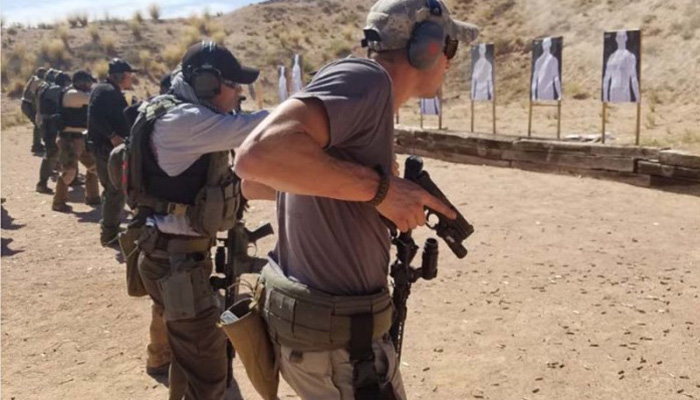
And it's not the sort of thing where people get more than relaxed with those rules every bit they become more experienced — in fact, the most advanced gun owners are typically the most stubborn nigh these rules because they know how of import this framework is. That'due south why you'll hear quondam timers angrily phone call out things like "muzzle discipline!" at the shooting range when someone new waves their barrel in the wrong direction.
Information technology is your responsibility that firearms are safe, secure, and locked away from people or children who shouldn't get to them. There are i.7 million children in the US that alive in homes with loaded but unlocked firearms. There are often serious legal punishments if you are careless with a gun, like leaving a loaded gun where a small kid can access it.
Be prepared. Don't exist a victim.
Want more than nifty content and giveaways? Sign up for The Prepared'due south free newsletter and get the best prepping content straight to your inbox. ane-two emails a calendar month, 0% spam.
The basic steps and gear yous need
If you simply desire to go from "never had a gun" to "the bare minimum to protect myself and be responsible", this is a typical prepare of needed gear and steps to take:
-
- Read this guide and the best first guns guide and so y'all take general ideas of what you desire to end up with.
- Go to a local gun store or shooting range where you tin piece of work with a salesperson or teacher to try firing some weapons before choosing which to buy.
- Meliorate yet, go with a trusted buddy who can loan you and teach you with their gear.
- When you lot buy, the firearm should come with a wire prophylactic lock that loops through the chamber and magazine, making it physically incapable of firing. It may also come with a skillful-enough storage/carrying case y'all can use until buying a proper one.
- If yous live in a household with at-take a chance people (kids, suicidal, handicapped), go a lockbox or gun safe to keep the gun and ammo out of the wrong easily.
- Purchase ammo. Y'all'll apply at least a few hundred rounds to practice with and go to know your weapon. It'due south okay to buy cheaper rounds while you're learning the ropes.
- Read the manual to learn how to make your specific firearm condom, how to load and unload it, whether the manufacturer suggests any steps for breaking it in, and how to perform a basic "field cleaning" (the maintenance you'll do afterwards a solar day of shooting).
- Buy a gun cleaning kit specific to your caliber.
- You'll demand ear and centre protection (unless you wear sturdy glasses).
- Sign upwardly for a local beginner's class, which can be as uncomplicated as a ane-hour lesson on a weekend afternoon. If you go to a shooting range outside of an organized class, don't exist afraid to enquire for help.
- You don't demand to become a gun-slingin' marksman, but you practise need to experience proficient. A chaotic, emotional emergency is not the fourth dimension to be fumbling with a gun. Spend a few days learning the basics, and try to dust off the cobwebs once a yr — shooting accurately and safely is a diminishable skill, meaning it needs a little practice one time in a while.
How to buy a gun
Y'all tin can purchase in person or online. If y'all're totally new to firearms, experts suggest y'all buy in-person considering you can feel how different models fit in your manus and ask questions.
Some gun stores and shooting ranges allow you lot to rent various guns. That'due south a great idea for new shooters and so you lot can get a feel before you buy.
Review: Best first guns
And if you've never shot before, don't worry! Stores beloved new shooters because you're a new customer that will keep buying new toys. Just say you're new at this and looking for help.
Don't be intimidated past going into a gun shop due to cultural differences. Fifty-fifty if you're the nigh pride-flag-waving liberal with your Bernie/Warren 2020 shirt on, whatever store worth your business organization volition treat yous with the same respect as a cowboy in an NRA hat.
Thankfully, the vast majority of legit businesses conduct themselves this way. If they don't, then say thank you, leave, and share your feel on review sites.
If y'all practice buy online, buy something new from a legit source. There are websites where individuals tin sell guns to each other (which still goes through a background check). There are bonafide people and good deals in those marketplaces, but as a new shooter you probably don't know enough all the same to spot the actually bad deals. And once you lot detect out information technology's probably too late. Guns do go through a lot of clothing and tear, after all.
Legal process
Dissimilar states and cities have wildly dissimilar laws about the types of guns you can buy, who can buy them, what you can practice with them, and so on. Some places like San Francisco, Chicago, and D.C. try to ban virtually or all guns altogether.
Be sure to google for your local laws. Wikipedia has a nice breakdown summary by US state.
Some general requirements:
- Over 21. Some areas allow people 18-21 to purchase rifles and shotguns for hunting.
- Have not been bedevilled of a felony.
- Have not been alleged mentally incompetent.
- Are not using medications or drugs that will impair your ability.
In nigh all cases at that place volition be a criminal background bank check. You'll make full out a form and the store will run you through a federal database that unremarkably just takes a few minutes to verify.
Cannabis: Note that even if yous live in a state with legal marijuana, it'southward still a crime at the federal level. These forms volition ask if yous are a "user of illegal drugs including marijuana." At that place are no drug tests or verification.
Every gun has a series number. Some states crave you to register your gun and series number in a government database.
Some states require a waiting or "cooling off" menstruation. Which means you pick your gun, pay for it, and do the background bank check but then you tin can't take information technology home for a while. The political thinking is that if someone is angry and walks into a store to purchase a gun, by making them wait 7-x days to carry it home they will absurd off and not commit whatever crime they were intending.
Basic ammo terms: bullets, calibers, and clips vs magazines
Since the whole point of a gun is to make a chunk (or chunks) of metal fly downrange and hit a target, we'll start in that location, with the ammunition.
What many people call a bullet is really called a round. Like a "round" of drinks. Simply you lot'll nonetheless hear people utilise the word bullet as slang for the whole cartridge.
A bullet is the specific function of the round that flies downwardly the barrel and through the air to your target. During the firing process, other parts of the circular are left behind and ejected as waste.
Other parts of the circular are the casing, which is typically a contumely, steel, or plastic housing that holds everything together. "Casing" and "contumely" are the ii nearly common lingo names.
Every round has gunpowder inside. That powder is ignited by a primer. That primer is a distinct circle in the eye of the base/rear on nearly ammo types. The popular and pocket-size .22 LR ammo, withal, uses "rimfire" where the spark happens from smacking on the outer lip of the casing, rather than a distinct primer in the eye.
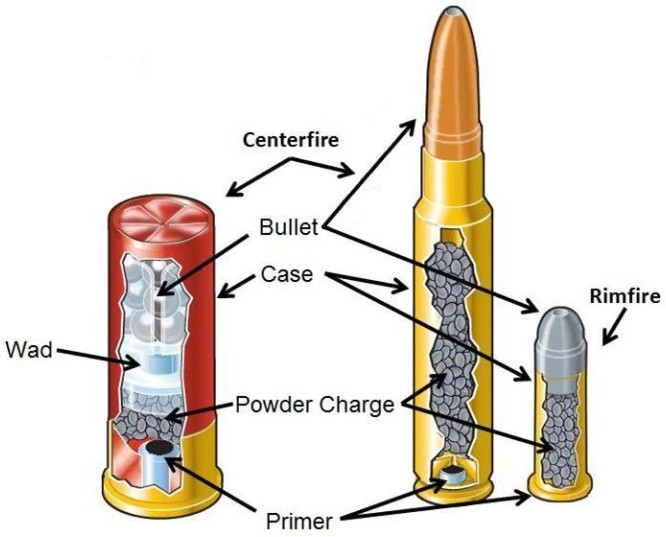
Shotgun ammunition is a little different because it fires lots of little projectiles instead of one bullet. That's why shotguns are used in bird hunting — information technology'd exist too hard to hit a flying bird with just i pellet, so you fire a agglomeration of pellets at one time that spray out in a larger zone.
Shotgun ammunition is chosen a "shell," or "shotshell", and the bullets are called "shot." Merely the principles are the same. You have a casing with a primer, gunpowder, so the projectiles that are launched downwardly the butt.
Some types of guns — particularly revolvers and shotguns — are designed to agree a few rounds of ammo inside the main body. Other types hold the ammo in a separate, detachable housing that you load into the main torso of the gun.
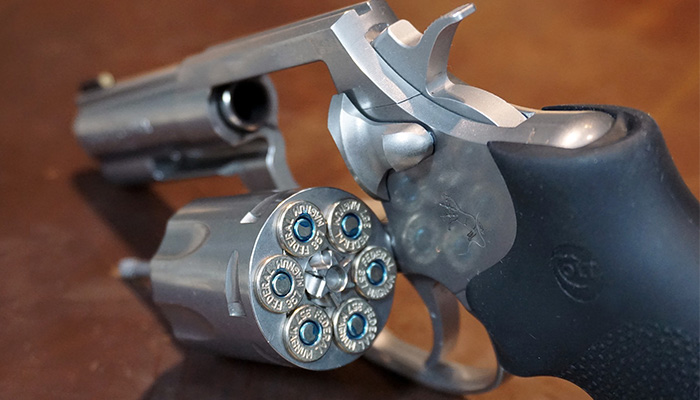
Those detachable containers are called magazines. Many people make the mistake of calling those clips, but a prune is a specific blazon of former-school housing yous likely won't ever employ.
Review: Best magazines
Most states in the Us limit the size of magazines to 10, fifteen, or thirty rounds in a unmarried container. Their thinking is that past limiting how many rounds are in a unmarried mag, it makes it harder for a criminal to shoot lots of bullets since they have to take the time to supervene upon an empty magazine with a new i. But that likewise creates limitations in something like a abode-defense situation, too.
Bullet sizes (ammunition types and calibers)
Let'due south say you know y'all want to become a pistol. I of the next big decisions is deciding what kind and size of armament yous desire to shoot.
Since the whole point is to sling metallic downrange at a target, what metal you're slinging can have an impact on everything else: how far it tin go, how fast, what kind of sound it makes, what kinds of materials it's meant to dial through, what the kickback feels like on your arm and shoulder, etc.
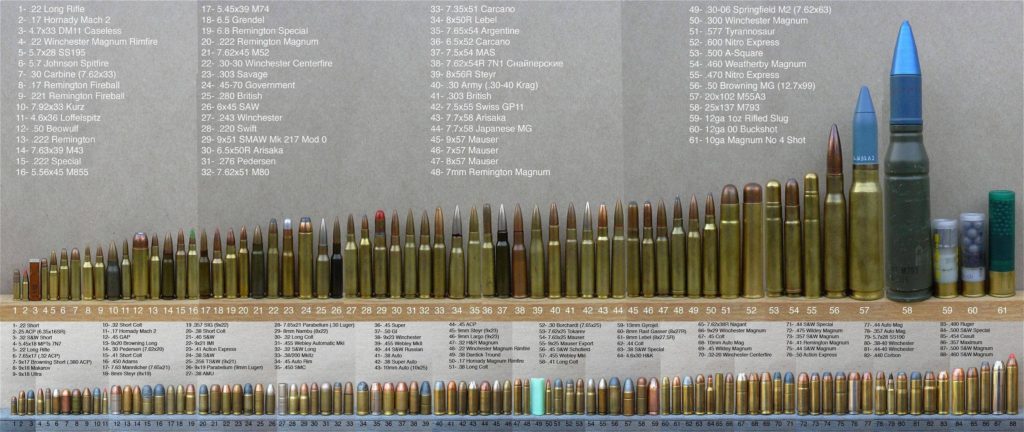
The way people place one size versus another is by "caliber", which is usually defined by the diameter of the casing. eg. a .308 circular is wider than a .223.
There are other measurements that might thing every bit well, such as the length of the casing. So sometimes you lot'll run into a label like "9×19" which means the diameter is 9 and the length is nineteen. But ordinarily the length is standardized and unsaid — eg. people know that a .223 is ever 2.26 inches long, so the ammo box only needs to say ".223".
Unfortunately, it won't always be measured in millimeters or even follow a logical pattern. Because America is stubborn and refuses to join the rest of the globe, sometimes things are measured in majestic and sometimes in metric. You'll somewhen learn the equivalent matches, similar how the .223 inch imperial measurement is substantially the same as the v.56 mm metric measurement — that's the quotient the NATO military organization has standardized around then they can share supplies across unlike countries and units.
Sometimes the differences seem small, like the nine millimeter round vs. the 10 millimeter round. Only these are precision-built machines with exploding parts, so every fraction of a millimeter or extra grain of gunpowder matters.
There will often be a word or name after the numerical part of the quotient, like ".223 Remington." For example, Remington is a gun company and designed the popular .223 Remington circular used in AR-15s. Just the specs are open source. You don't have to use that round in a Remington gun and plenty of non-Remington companies now make the .223 round.
Shotgun ammo sizes (gauges) work differently
Shotgun ammo types are simpler in that there's fewer to choose from (only most eight). But the naming convention is often more confusing than standard pistol or rifle bullets, and in many ways is a leftover from before the industrial revolution.
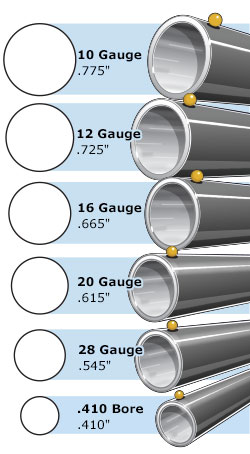
By far, the two virtually common shotgun sizes are 12 judge and 20 estimate. A 12 gauge is bigger than a xx, nonetheless.
Imagine y'all start with a one-pound cake of lead and desire to make spherical pellets to use as shot in a shotgun shell. The bigger you make each ball, the fewer balls y'all'll be able to make from a single i-pound block. That'south why the gauge number goes down as the shot size goes up.
Another way to think near information technology: it would take 20 atomic number 82 balls with the aforementioned diameter as the barrel of a 20-gauge shotgun to weigh one pound.
There are other words involved in shotshell labeling, such as "Buckshot" or "Birdshot." Nosotros become deeper into this in other guides, but the general idea is the label means what they're meant to chase. Taking down a buck (deer) takes more force than a bird, so buckshot is configured differently than birdshot. If you shoot a methed-up home intruder with birdshot, for instance, they volition drain but might not be hurt enough to go down.
Types of guns
- Pistols / revolvers / handguns are small plenty to be held and fired with one hand (although you should use two). Good for shut targets up to 25 yards abroad (23 meters), but can be constructive up to 50 yards (46 meters).
- Shotguns typically require two hands and are held against your shoulder. You might have seen them use past hunters or people who shoot clay targets (the sport where people yell "pull!") Adept for targets up to 50 yards away (46 m), possibly upwards to 75 yards (68 chiliad).
- Rifles are large, usually requiring both hands and being held confronting your shoulder. Skilful for targets upwardly to a mile abroad (1.6 km), although the virtually common models are meant for 100-400 yards (91-365 chiliad).
The blazon of ammo used is typically dependent on the type of gun. Shotgun ammo is always limited to only shotguns. Nearly pistol and rifle ammo is split up, although there'south a few options that are used in both types.
Since the ammo and goals/part are unique for each category, this is oftentimes one of the beginning decisions new gun owners have to brand. Some people might cull a pistol because it'south cheap, uncomplicated, and easy to carry, for example, while others might choose a rifle because information technology's more versatile and powerful.
Basic gun terms / parts
It's easy to go far the weeds on all of the trivial parts and names, but here's the big stuff you should know as you learn more, brand your first buy, and navigate local laws:
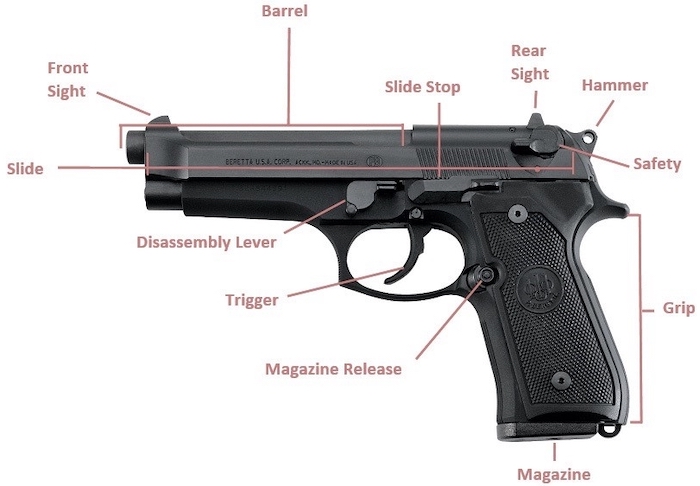
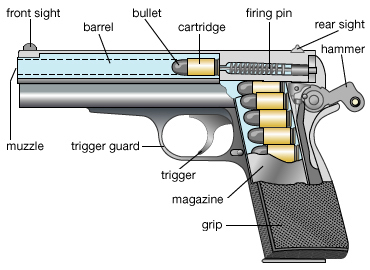
-
- Stock is the part that extends back towards your shoulder, with a "butt" on the end where it makes contact with your body.
- Barrel is the portion from where the unfired bullet sits through the cage opening where it flies out.
- Chamber is the spot where an unfired but loaded bullet sits, waiting.
- Hammer, striker, and firing pin are the pieces that strike the cartridge primer, igniting the gunpowder.
- Rear and front sights, which are built into the frame, versus optics/scopes that are added separately.
- Track are parts of the frame that make it easy to attach accessories.
- Mag and mag well (where the magazine slides and clicks into). A magazine release is the push button y'all press to drib the magazine out from the frame.
- Grip is where y'all concord with your dominant hand. A foregrip is an accessory or part of the frame in front of the trigger where you place your off manus for added stability.


Local gun laws are part of why it's handy to know these names. Instead of making laws that focus on bad people and what causes them to practise bad things, many governments instead regulate the specific mechanical pieces and designs for anybody.
For example, in well-nigh places you are not immune to ain a burglarize with a barrel less than 16" unless you lot go through special background checks. And part of what makes the legal difference between a burglarize with a brusque barrel and a pistol with a long butt is the buttstock — if a gun has a buttstock you concur to your shoulder (creating 3 points of contact vs. a pistol'due south ii), it's generally classified as a rifle and subject to those laws.
Similarly, some places limit or prohibit the use of vertical foregrips or detachable magazines. Then if you detect yourself in a place like California, you lot'll need to learn how local laws regulate "evil features."
How guns work
Guns work similarly to a car engine:
- Fuel is put into a small enclosed space (the piston cylinder).
- The enclosed fuel is then ignited by the spark plugs.
- Explosions create gas and energy that wants to rapidly expand outwards.
- But since it's an enclosed space, where does that gas/free energy go?
- Engines are designed so that in that location's only one direction that energy/gas can go — by pushing the piston away from the explosion.
- The force pushing the piston away is what eventually turns the axle and tires.
That "create an explosion in a tight space with but one mode to escape" model is the same for firearms.
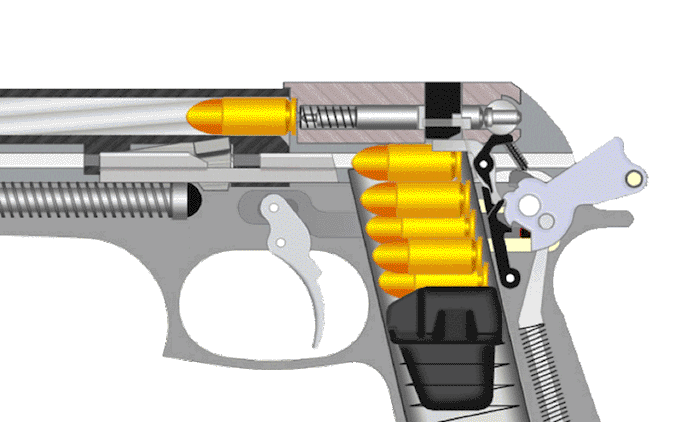
When you lot pull the trigger, a mechanical striker or firing pin hits the primer on the bottom/back of a circular, sparking the explosion inside the casing. The explosion pushes against the back of the bullet (or the wad in a shotshell), forcing it to separate from the casing.
That energy keeps building every bit it continues pushing downward the barrel. That's why you might come across "muzzle flashes" or small flames coming out of the cease of the barrel equally the bullet escapes — that'southward the leftover gas chop-chop burning off now that it has room.
In fact, that'southward why bullet speed and barrel length are often correlated. The more time a bullet and the gas/energy backside it are kept in that one-way-escape tube, the more time the bullet has to gain speed (and stability) before the energy is dispersed in the air.
Unmarried shot vs. semi automobile vs. full auto
What happens later on the explosion pushes the bullet/shot out of the barrel? There has to be some kind of reset to eject the leftover casing and make room for a new round to burn. How that happens is the difference between labels like semi-machine or full-auto.
Think about the old-schoolhouse guns used back in the 1700-1800s. You've seen in movies how people would burn one shot, then take an cool corporeality of time to reload the gun. Burn down, manually reload, burn, manually reload, echo.
Those are unmarried-shot guns. The gun doesn't "do" anything else one time information technology's fired. You lot have to do a physical movement with your hand to eject the erstwhile round and bring in a new one.

In that location are withal guns like that today. The main benefit is better accurateness since there are fewer moving pieces during the explosion, which should (in theory) help keep the muzzle more than stable. That'south why nigh precision rifles are single-shot "bolt-action" guns.
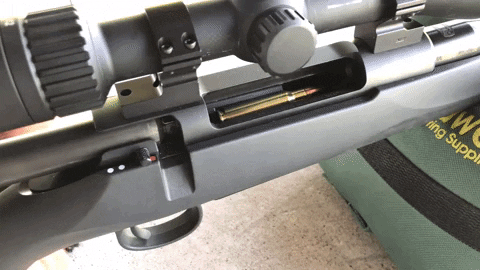
In a auto engine, the momentum gained from the first explosion is what helps the car rotate around and reset itself for the next bike.
The fundamental innovation that took u.s.a. from 1800s-manner guns to modern weapons is similar. Instead of letting the gas but escape in one direction (out the barrel), designers add a second escape path in the opposite direction. Newton'due south Tertiary Law of Physics says every action has an equal and opposite reaction. So the aforementioned strength pushing the bullet towards the forepart is also pushing backwards towards your trunk.
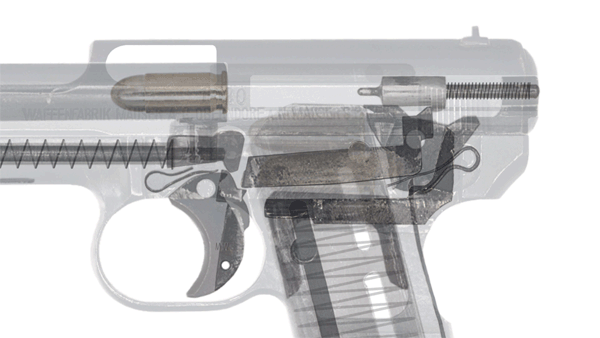
Semi-automatic and fully-automated guns take advantage of that rearward force, using it to perform other mechanical deportment such as physically ejecting the just-fired waste product casing. Then it becomes a loop that feeds and resets itself every time a bullet is fired.
Which brings united states to semi-motorcar versus full-auto:
- Semi-automatics reset themselves after firing a round, just and so they sit there, waiting for yous to pull the trigger again.
- Full-automatics volition keep cycling through the loop as long as the trigger is held down. Similar to how your auto engine keeps cycling as long as you have your human foot pressed downwardly.
A well-trained person using a semi-auto gun in platonic conditions can fire upwardly to 100 rounds per minute. In reality, you might max out at 40-50 rounds per minute (and even then you'll exist limited past magazines etc.)
Full-automobile guns tin shoot hundreds or even thousands of rounds per minute — just like a motorcar engine that can cycle thousands of times per minute.
More: A not bad animation of how an AK-47 tin fire in semi-auto and total-machine.
But that's why full-automobile guns are illegal basically everywhere. If you have to pull the trigger for each bullet, that theoretically makes things 'safer' than if you could just squeeze once and send a lot of bullets firing very quickly.
At that place are some small exclusions for older grandfathered weapons (eg. built before 1986), only you have to pay a huge amount of money, go through years-long background checks, your habitation can be searched at whatsoever time without a warrant, you can't cross state lines without permission, etc. It'due south extraordinarily rare for a full-auto weapon to exist used in a crime.
Unmarried action vs. double action
Cocking a gun is the process of putting the hammer or striker (basically the same thing) in a leap-loaded position, then that when y'all pull the trigger, that hammer/striker tin can wing forward to hit the ammo primer and cause a spark.
Then there are two mechanical actions here: spring-loading the striker, and then pulling the trigger to release it.
A weapon volition be classified as single action or double action based on whether or not you can do both of those actions in ane mechanical motion, or if you have to use your hand to physically cock the gun earlier pulling the trigger.
Archetype revolvers have the hammer protruding out the back, and then you can use your thumb to cock the weapon. This gif shows a unmarried action:
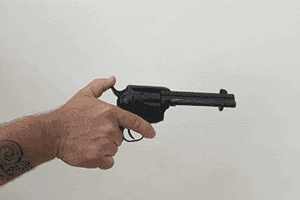
A double action firearm is one where yous tin both cock and release the hammer/striker with just a trigger pull. The first function of the trigger pull cocks the hammer, while the stop of the pull releases information technology. That means you can take a gun from uncocked to artsy and fired with just one finger pull.
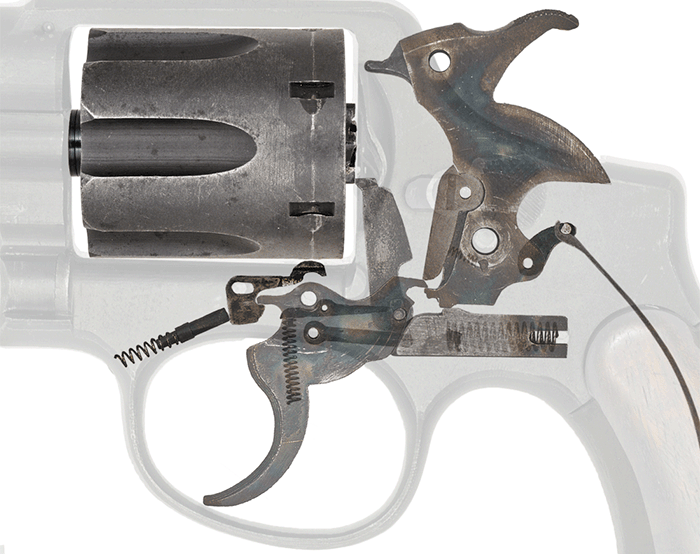
For most of the weapons you'll use, this only matters for the starting time trigger pull (taking the gun from common cold to hot) because the semi-automobile reset wheel volition cock the trigger for your follow-upward shots. That means you might take a double action gun that uses on the first pull but then becomes a SA on the following pulls.
Here's a decent youtube video if you want more than info.
Assail rifles, assail weapons, and AR15s vs AK47s
We're specifically calling out assault rifles and AR-15s because there is a ton of disinformation in gun conversations (both innocent and intentional).
Outset, there is no real definition for an "attack weapon" — it's but a made up term people utilize for guns they call up are more unsafe than others. Even though two different models might use the aforementioned type of bullet that has the same type of power, speed, and capacity, weapons that wait like they're from the armed services or an action movie oftentimes look scarier to people who don't empathise. They're sometimes referred to as "blackness guns" because they tend to exist a solid blackness colour and made entirely of metal, instead of a more traditional wood design, and that somehow looks more than unsafe.
Information technology'south true that some guns accept more subversive potential than others. A minor revolver, for example, is not designed for big-scale cocky-defense the way an AR-15 is. But people oftentimes let perceptions override logic.
"Assault burglarize" does accept a definition, but virtually everyone misuses the label. In reality, an attack burglarize must accept certain criteria, such as "select fire" functionality that lets the user switch from semi-auto to total-car fashion — but those features are already very strictly controlled by law and mostly left to the armed services and constabulary enforcement, so very few civilians actually have an attack rifle.
A civilian AR-15 is a specific blazon of semi-automatic rifle. The AR does not stand for Assault Rifle. Information technology actually stands for ArmaLite, the visitor that first designed them. Over fourth dimension it became the most popular rifle platform in the western world and hundreds of companies now brand their own variations of the AR-15 design. You tin can buy an AR-15 office from one visitor and it will usually piece of work with an AR-15 part from another visitor.
And so the name AR-15 has get one of those ubiquitous names like Tylenol or Xerox, and it morphed over fourth dimension to mean whatsoever rifle based on that design. Many ignorant media reports volition fifty-fifty refer to "scary" guns as an AR-15 even though the specific model is non fifty-fifty in the same category.
An AK-47 is basically the Russian equivalent of the AR-15. It has some design differences (the parts are not interchangeable) but fulfills essentially the same role. The AK-47 was inexpensive to brand and maintain, which was of import in the Soviet Wedlock. It became very popular in the former Soviet countries and has since spread on the black market place to be the weapon of choice for Middle Eastern terrorists, African warlords, etc.
Suppressors and "silencers"
What movies call "silencers" are actually called suppressors — more often than not because you tin can't brand an explosion silent, y'all can only muffle information technology.
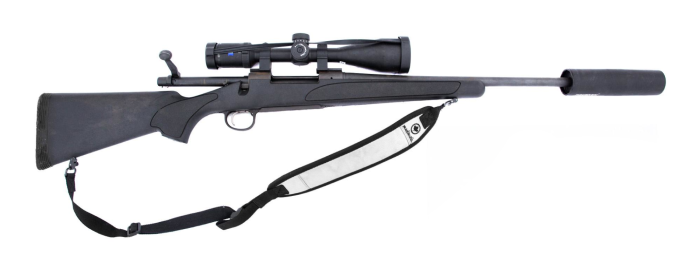
Adding a suppressor (or "can" in slang) to a firearm does not make it whisper silent. At best, a suppressor will reduce the overall noise to a level that won't medically injure your ears and it eliminates the sonic boom created by some faster-than-sound bullets.
For case, many people'south "bedside gun" uses a naturally-quieter weapon/caliber paired with a suppressor. That style if you take to fend off a home invader, you don't blow out your and your family'south eardrums or take to rely on putting on earmuffs in the moment.
Review: Best shooting ear protection
In yet another example of the disconnect betwixt reality and the fear/media/legislation around firearms, suppressors are heavily regulated in the Us under NFA laws considering of this perception that suppressors somehow make the public less safe. This comes in part from movie tropes about stealthy assassins with whisper-quiet pewpews, even though at that place's no data to suggest cans correlate with violence.
Contrast that with Europe — which by and large has much stricter gun laws than the United states of america — where you tin can just buy a suppressor over the counter without any fuss.
That's because the only existent value of a can is to brand shooting safe on the ears. That's why some in the US Congress are trying to pass the Hearing Protection Human action.
Source: https://theprepared.com/self-defense/guides/beginners-guide-to-guns/
Mag-post ng isang Komento for "Everything You Need to Know About Guns and Ammo"